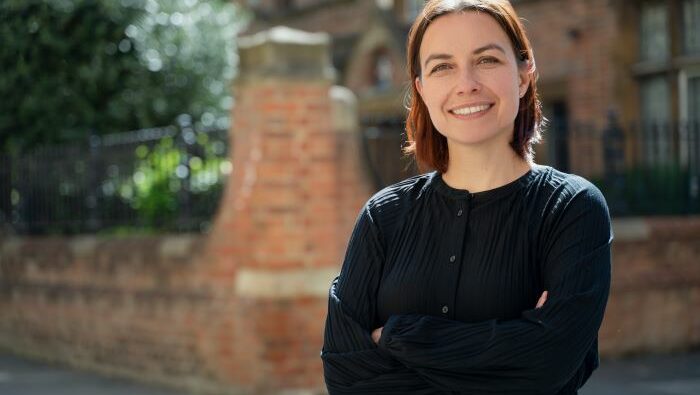As we mark International Women’s Day, Professor Ekaterina Hertog spoke to us about AI, the increase of automation in the home and its impact on women and wider society. She considers whether AI and greater automation in the home have the potential to help alleviate some societal inequalities and lead to greater inclusion for women and under-represented groups in the workplace and wider society.
Can you tell us a little about your current research on AI, automation in the home and its significance for women as we celebrate IWD 2024?
Katya: My research lies at the intersection of digital sociology and family sociology. I lead an ESRC-funded Domestic AI project at the Oxford Internet Institute, University of Oxford, that explores the potential of new gadgets and apps to free up time now locked into unpaid housework and care work. Together with my team, we also investigate how willing people are to introduce these technologies into their private lives.
Smart, digitally connected household robots are becoming more common. Examples include cooking robots, such as Thermomix popular in Germany and several other European countries, as well as robotic vacuum cleaners, window cleaners, and lawnmowers. These technologies can save people time currently locked into domestic labour and free them up to do other things. At the same time, these gadgets still need some level of human input, whether tidying up before setting the robot vacuum cleaner to work or getting all the ingredients ready for the cooking robot.
Technology certainly has the potential to transform domestic work, but there are several barriers to full-scale adoption, both at an individual level and societal level.
Looking at this issue from an individual perspective, in a research paper* my team and I published last year we find that male and female experts imagine the usefulness and marketability of domestic automation technologies quite differently, especially in a highly gender unequal society like Japan. We found that female experts were more excited by the potential of the technology to take over domestic tasks, while male experts were more likely to point out that many domestic tasks would be quite expensive and therefore domestic automation will not be of interest to consumers. Female experts agreed with male experts that automating domestic work is not cheap but were more likely to maintain that such automation will be of interest to consumers even at a high price. A number of female experts we spoke to highlighted that they would be keen adopters of robots or other technologies that would help them with household chores.
Do you think that technology can help bring about greater equality for women in society, thinking about your own research in particular?
Katya: Technology is often talked about as our saviour, but it has limitations. It can be a useful tool to combat social inequalities if adopted thoughtfully, but it can also easily amplify inequalities rather than reduce them. Many social problems that cannot be solved through technology, or at least not through technology alone.
Let’s take gender inequality in domestic labour as an example and consider the role technology might play in helping to alleviate some of those inequalities with some practical examples. First, as I’ve already touched on, technology is to a significant extent shaped by the imaginaries of those behind its development and the most potentially useful technologies may not get developed or reach the market for social rather than technical reasons. If the people behind the development of the robots or apps that could help in the homes have a particular view of domestic work, because maybe they are able to outsource much of it, that will influence which technologies are developed and make it to the market and which never see the light of day.
Second, technologies have the potential to transform tasks, but this transformation by itself may not be enough to bring about substantial social change. Let’s consider the case of a washing machine. Washing machines made the task of keeping laundry clean a lot easier and less time-consuming. They were powerless, however, to challenge the social roles which expected women to do the lion share of domestic work. Moreover, as the widespread adoption of washing machines led to an increase of hygiene standards, much of the time freed up by the washing machines was immediately taken by domestic tasks around laundry washing, such as folding and ironing, that became more time consuming with the increased frequency of washing clothes. Finally, if technologies that help with domestic work come with a significant price tag, they may reduce gender inequality, but only in richer households.
Technology lives within the broader ecosystem of family and society, influencing how individuals engage with technology and what risks and opportunities they are exposed to. With the examples above I highlight the fact that technologies can help solve prevailing social problems, including gender inequality, but for this to happen we need thoughtful and principled design effort as well as broader attention to social barriers to gender equality and consideration for policy solutions going beyond technology.
We also need to think about our values and how these may influence the solutions we opt for. For example, do we want a kitchen robot to save us time on cooking family meals or do we want our jobs to be more flexible so all family members can spend more time cooking and share the household chores equally?
Your research could have a big impact for women, do you expect tech and AI to improve equality for women?
Katya: We need to think about how these AI tools are designed and who makes the decisions about what kind of technology we’re going to invest in. Tech sector tends to be male-dominated, with women and other under-represented groups having limited input in the solutions that make it to market.
We see decisions about AI technologies in the home being made by people who historically and on average, even today, do less domestic work and whose lives are less structured by the different types of domestic work as the burden still tends to fall more on women, despite some of the progress that’s been made with men contributing more in the home.
Technology is certainly a tool that we can use to improve our everyday lives, but these bigger structural issues need to be addressed before we see real long-lasting change.
What can be done to inspire inclusion in the way AI technologies are developed?
Katya: A lot of people are sounding the alarm about the way AI is developing so quickly without sufficient checks and balances in place and often with limited input from the groups most affected by its adoption. It’s been said that AI often simply reproduces existing inequalities rather than breaks the mould and I agree with that to a degree.
The transformative impact of AI depends to a large extent on the design decisions we’re making now and our ability to plan strategically for the outcomes we want to see which truly reflect a diverse society.
Breaking down social barriers and reducing inequalities inherent in AI technologies won’t happen by itself. It’s about several factors, design, regulation, active strategic planning and decision-making, and optimising the tech for multiple goals, whether profit, diversity, or well-being, although it’s usually all of these things to some extent.
What do you hope will be different for women in the age of AI and what concerns you?
Katya: The technologies that get designed and funded are the ones that predominately feature on the mental maps of the people in power at the helm of these big tech companies, which disproportionately tend to be white men. Looking ahead, I’d like to see greater diversity and inclusion at top, which is then reflected in the AI technologies that get launched to the market. It’s not just about including women’s experiences, which is very important, it’s also about including the voices and experiences of other groups that are currently under-represented.
I’d also like to see more work done around measuring the consequences of implementation of AI technologies and their impact on women and under-represented groups. All too often there is a rush to launch the latest innovative AI tool in a media fanfare and just put it out there, without the software developers building in any type of tracking facility to see what the consequences of the technology are and the effects it has on people’s lives. For example, facial recognition software used in education was better at authenticating white rather than non-white faces which racial inequalities to test taking, but that only got picked up once a large number of children were negatively affected.
Katya: Often, any issues with the technology only get raised when it has been adopted at scale, and by then it is often costly and time consuming to make changes to design to address observed bias or minimise any other unintended consequences of implementation further down the line. Having a process which mandates at least some level of participatory design, a pilot stage, and regular post-implementation checks would be important to achieving a more inclusive future in the age of AI.
And finally, what advice would you give to other women in the tech industry this IWD?
Katya: I’ve learned a lot about how AI can exacerbate and generate inequalities, both from my research in the field of domestic AI and my own experience juggling my professional life with my personal life. I’ve been fortunate in that before having a family, I was able to see some of the data around how much time is spent on domestic work once you have children, which prompted me to have a very explicit conversation with my partner about how we were going to navigate balancing our working lives with our family lives once we had children.
Katya: I would encourage other female researchers just starting in this male-dominated field to think very strategically about their values and what they want to achieve in their professional and personal lives. Think about the work-life balance and how you will achieve sharing domestic and paid work responsibilities equally within your relationship, especially after having children.
Professor Ekaterina Hertog is Associate Professor in AI and Society at the Oxford Internet Institute and the Institute for Ethics In AI, in association with Wadham College.
Find out more about Professor Hertog’s current research project: *Domestic AI
Download her latest peer-reviewed papers:
The future of unpaid work: Estimating the effects of automation on time spent on housework and care work in Japan and the UK published by the journal Technological Forecasting and Social Change. Authors: Ekaterina Hertog, Setsuya Fukuda, Rikiya Matsukura, Nobuko Nagase, Vili Lehdonvirta
‘The future(s) of unpaid work: How susceptible do experts from different backgrounds think the domestic sphere is to automation?’ published by the journal Plos One. Authors: Vili Lehdonvirta, Lulu P. Shi, Ekaterina Hertog, Nobuko Nagase,Yuji Ohta
‘It’s not her fault’: Trust through anthropomorphism among young adult Amazon Alexa users Published by the journal Convergence. Authors: Elizabeth Fetterolf and Ekaterina Hertog



